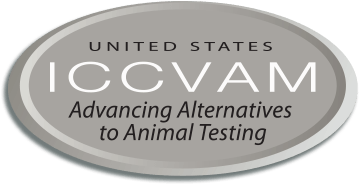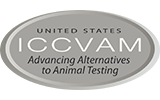Glossary of Key Terms
3, A-B
3Rs: the principles of replacement, reduction, or refinement of animal use for scientific research or product safety testing.
Accuracy: in the context of a test method validation study, the closeness of agreement between a test method result and an accepted reference value, or the test method's proportion of correct outcomes.
Acute systemic toxicity: the immediate or near-immediate effect of a toxic substance after it is absorbed and distributed throughout the body. Different acute systemic toxicities are distinguished by the route of exposure: by ingestion (oral), through the skin (dermal), or by inhalation.
Adverse outcome pathway (AOP): a conceptual framework constructed from existing knowledge that relates exposure of a type of toxic substance to subsequent steps that result in illness or injury.
Agonist: a substance that increases activity of the target receptor.
Algorithm: a set of steps that are followed to complete a computational process.
Allergic contact dermatitis: an allergic reaction that results from repeated direct skin contact with a skin sensitizer. Clinical signs of allergic contact dermatitis include redness, swelling, blistering, and itching.
Alternative methods: testing methods or approaches that replace, reduce, or refine animal use; the term new approach methodologies is also used and is becoming more prevalent.
Androgen: a class of hormones, produced largely by the testes, that serve as the primary male hormones.
Androgen receptor: a protein molecule to which an androgen or androgen-like substance can attach. This interaction produces a chemical signal or triggers a cellular response.
Antagonist: a substance that decreases activity of the target (estrogen or androgen) receptor.
Apoptosis: cell death that occurs as a normal and controlled part of an organism's growth or development.
Applicability domain: a range of chemicals and properties for which a test method has been proven useful.
Bioactivity: the manner in which a chemical affects or interacts with living tissue.
Biomarker: an objective measure that captures what is happening in a cell or an organism at a given moment.
Bioprinting: a process that combines 3D printing with biomaterials to replicate parts that imitate natural tissues, bones, and blood vessels in the body.
C-D
Cardiotoxicity: toxicity to the heart.
Chemokines: signaling proteins secreted by cells of the immune system that stimulate the movement of other cells.
Concentration–response curve: a curve on a graph that shows the relationship between the concentration of a chemical being tested in an assay and its measured effect on the assay endpoint.
Cytokine: a signaling protein that modulates the activity and development of immune cells.
Cytotoxic: the ability of a substance to kill or harm cells.
Defined approach (DA): a testing strategy that consists of input data generated from identified methods and a data interpretation procedure, such as a machine learning model, flowchart, or decision tree, through which the data are evaluated.
Developmental toxicity: effects observed in offspring that occur as a result of chemical exposures of the pregnant mother. Developmental toxicity effects may be apparent at birth or emerge later in the offspring’s life.
Dosimetry: measurement or calculation of a dose of substance delivered to a target tissue.
E-G
Ecotoxicity testing: refers both to the assessment of chemical effects on invertebrates, fish, birds, plants, and other wild organisms and testing of soil, sediment, or effluents for the presence of toxic compounds.
Endocrine disruptor: a natural or man-made substance that may interfere with the endocrine system and produce adverse health effects.
Environmental fate: characterization of how a chemical will behave if released into the environment; it is affected by properties such as biodegradability and soil adsorption.
Epithelial cells: any of the cells forming the cellular sheets that cover surfaces, both inside and outside the body.
Equivalent administered dose (EAD): the output of in vitro to in vivo extrapolation; the predicted in vivo dose that would result in a plasma concentration of a chemical equal to the concentration of that chemical that induces an effect in an in vitro assay.
Estrogen: a class of hormones, produced largely by the ovaries, that serve as the primary female hormones.
Estrogen receptor: a protein molecule to which an estrogen or estrogen-like substance can attach. This interaction produces a chemical signal or triggers a cellular response.
Ex vivo: refers to an assay using tissue that has been removed from a multicellular organism and conducted while the tissue is still viable.
Formulation: a mixture of chemicals prepared according to a specific procedure to ensure a desired effect when used, improve handling properties, or achieve other desired product goals.
G protein-coupled receptor: receptors located in the cell membrane involved in cell signaling. G protein-coupled receptors are important drug target and involved in many diseases.
Genotoxic: capable of damaging DNA.
H-I
Harmonization: the act of making systems or laws similar among different companies, countries, etc., so the organizations using those systems or laws can operate more easily within the different venues.
Hazard classification: assignment of a substance to a category according to results of toxicity testing, often for labeling purposes.
Hepatic: referring to the liver.
Hepatocyte: the main functional cell of the liver.
Hepatotoxicity: toxicity to the liver.
High-content screening: an approach that uses fluorescent tagging and automated imaging to assess changes in the structure and composition of individual cells in a high-throughput manner.
High-throughput screening (HTS): a testing approach that uses robotics, liquid-handling devices, detectors, and associated software to quickly conduct a large number of chemical or biochemical tests.
Hydrophobic: tending not to mix with water.
In chemico: refers to assays that are carried out in an artificial system, such as a test tube or assay plate, using only chemical components rather than cells.
In silico: refers to analyses that are carried out on a computer or via computer simulation.
In vitro: refers to assays that are carried out in an artificial system, such as a test tube or assay plate, using small single-cell or multicellular organisms, cultured cells, or cellular components.
In vitro to in vivo extrapolation (IVIVE): an analysis conducted to relate the test chemical concentration causing a response in an in vitro system to an external dose or exposure that results in human or animal (in vivo) illness or injury at the target tissue.
In vivo: refers to assays carried out using multicellular organisms, typically rodents or other mammals.
Induced pluripotent stem cells (iPSCs): a stem cell derived from a mature non-sex cell that has the potential to differentiate into various types of cells.
Integrated approach to testing and assessment (IATA): an approach that considers all available relevant information about a substance in a weight-of-evidence assessment to inform a regulatory decision regarding hazard or risk, or to indicate that specific additional tests are needed.
K-M
Keratinocyte: the major cell type of the skin.
LC50: in traditional animal tests for acute inhalation or aquatic toxicity, the concentration that causes death in 50 percent of the animals tested; a value used to categorize toxic substances and determine the hazard phrases used on product labels.
LD50: in traditional animal tests for acute systemic oral or dermal toxicity, the dose that causes death in 50 percent of the animals tested; a value used to categorize toxic substances and determine the hazard phrases used on product labels.
Leukocyte: any of the colorless blood cells of the immune system.
Machine learning: the study and construction of computer algorithms that, once trained on a set of data, can make predictions or decisions about a different set of data.
Metabolism: the sum of the processes by which a particular substance is handled in a living organism, such as assimilation and incorporation or detoxification and excretion.
Microphysiological systems (MPS): in vitro models of organs composed of cells and structural materials that are designed to reproduce the function of living organs; also referred to as organs-on-a-chip or tissue chips.
Microtiter plate: a flat plate with multiple wells used as small test tubes.
N-Q
Nanomaterial: a substance made up of particles that measure no more than 100 nanometers in at least one dimension.
Neurotoxicity: toxicity to the brain or other parts of the nervous system.
New approach methodologies (NAMs): testing methods or approaches that replace, reduce, or refine animal use; the term alternative methods has also been widely used.
Nonclinical testing: evaluation of candidate drugs conducted in animals or in vitro assays, typically before testing in humans to assess toxicity and determine safe doses; the term preclinical testing is also used.
Ontologies: standardized nomenclature systems.
Organophosphorus compounds: organic compounds that contains phosphorus; many are used as pesticides.
Per- and polyfluoroalkyl substances (PFAS): a class of manufactured chemicals that are widely used to make various types of common products. While their potential health impacts are mostly uncharacterized, they are of concern because they resist degradation, accumulate in an organism’s body over its lifetime, and are widespread in the environment.
Pharmacokinetics: an evaluation of the rate at which a chemical is absorbed, distributed, metabolized, and excreted once it enters the body, as a means to determine the relationship between exposure and toxicity (see also toxicokinetics).
Pharmacokinetic (PK) model: a mathematical model created to describe the process of absorption, distribution, metabolism, and excretion of a chemical through the body. One-compartment models treat all organs as a single unit, whereas physiologically based (PBPK) models are usually multicompartment models with separate compartments corresponding to individual or combined organs that are interconnected by blood flows.
Phenomics: the systematic study or evaluation of the traits that make up a phenotype, often in a high-throughput manner.
Phenotype: observable characteristics of an organism resulting from the interaction of its genetic makeup with the environment.
Physicochemical properties: referring to the physical or chemical properties of a substance.
Point of departure (POD): the lowest dose or concentration at which a treatment-related response is observed.
Population variability: the potential for genetic or nongenetic factors to impact susceptibility to toxic effects of chemicals, resulting in observed differences in both effects and severity of effects of chemical exposure to individuals within a population.
Proteomics: comprehensive evaluation of the function and structure of proteins undertaken to understand the effects of a chemical on a tissue or organism.
Quantitative structure-activity relationship (QSAR) models: classification models that predict the activities of chemicals with unknown properties by relating them to properties of known chemicals.
R-S
Read-across: a computational technique that uses toxicity data from one or more known (source) chemicals to predict toxicity for another (target) chemical, usually but not always on the basis of structural similarity.
Reference chemical: a chemical that causes a specific well-characterized biological effect, and therefore, can be used to assess the performance of a test method designed to measure that effect. Reference chemicals should represent the classes of chemicals for which a test method is proposed to be used and cover the range of expected responses.
Reference data: data from an accepted test method that can be used to assess the performance of a new test method designed to measure an analogous effect.
Refinement alternative: a test method that modifies procedures to enhance animal well-being and that lessens or avoids pain and distress in animals.
Relevance: the extent to which a test method accurately measures a biological effect of interest in a species of interest.
Reliability: the extent to which a test method provides reproducible results over time and in different laboratories.
Replacement alternative: a test method that replaces animals with a non-animal system or one animal species with a phylogenetically lower one.
Reproductive toxicity: chemical effects on the reproductive system that interfere with an organism’s sexual function or fertility.
Risk assessment: the process of characterizing the potential risk posed by a chemical, taking into consideration the hazards posed by the chemical, the dose of the chemical needed to cause health problems, and the probability of exposure at that dose.
Sensitivity: in the context of test method validation, the proportion of all positive substances that are correctly classified as positive by the test method under evaluation.
Skin irritation: minor injury or inflammation to the skin; irritation differs from an allergic reaction in that there is no coordinated response from the immune system.
Skin sensitization: a hypersensitivity that occurs when a susceptible person comes in direct skin contact with an allergen, termed a skin sensitizer.
Skin sensitization potency: the relative amount of a substance that produces a skin sensitization reaction.
Specificity: in the context of test method validation, the proportion of all negative substances that are correctly classified as negative by the test method under evaluation.
Stem cells: undifferentiated cells of a multicellular organism that can indefinitely produce more cells of the same type and can also be induced to differentiate into other types of cells (see also induced pluripotent stem cells).
Subchronic: animal experiment designed to study effects produced by the test substance when administered either in repeated doses or continually in food, drinking water, or air over a period of up to about 90 days.
Sublethal: a dose or concentration of a substance that is not high enough to cause death.
Synbiotics: mixtures of probiotics (helpful gut bacteria) and prebiotics (non-digestible fibers that help these bacteria grow) that work together synergistically in the digestive tract.
T-X
Tox21: collaborative effort among four U.S. federal government agencies to develop more efficient approaches to predict how chemicals may affect human health.
Toxicant: a toxic or poisonous substance.
Toxicokinetics: an evaluation of the rate at which a chemical is absorbed, distributed, metabolized, and excreted once it enters the body, as a means to determine the relationship between exposure and toxicity (see also pharmacokinetics).
Transcriptomics: the analysis of overall gene expression in a cell or tissue to assess cell function or response to toxicity.
Validation: a process by which the reliability and relevance of a test method are established for its intended application.
Xenobiotic: a chemical found within an organism that is not naturally produced or expected to be present within the organism.



